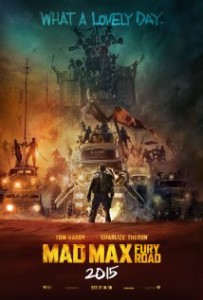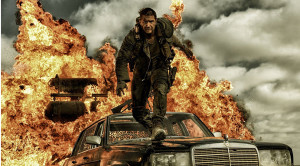 Just when you thought that Avengers: Age of Ultron was destined to be the most action-packed and relentless film of the blockbuster season, Mad Max: Fury Road comes thundering into theaters. Director George Miller has returned to his beloved franchise after a thirty-year break, and the result is a movie imbued with so much passion and–ahem–fury that it threatens to overwhelm the senses. Fury Road is a hard-hitting chase film, an action movie in every sense of the term: it’s big; it’s loud; and it’s relentless.
Just when you thought that Avengers: Age of Ultron was destined to be the most action-packed and relentless film of the blockbuster season, Mad Max: Fury Road comes thundering into theaters. Director George Miller has returned to his beloved franchise after a thirty-year break, and the result is a movie imbued with so much passion and–ahem–fury that it threatens to overwhelm the senses. Fury Road is a hard-hitting chase film, an action movie in every sense of the term: it’s big; it’s loud; and it’s relentless.
Part and parcel to Fury Road’s action movie-ness, therefore, is a commitment to a minimalistic, stripped-down plot; in fact, if you’ve seen the trailer, you know just about all there is to know about Fury Road. Max (Tom Hardy) is on the run from the brutal and sadistic ruler of this particular post-apocalyptic region, Immortan Joe (played by Hugh Keays-Byrne, the infamous Toecutter in the original Mad Max). He soon finds himself in the company of his female counterpart, Imperator Furiosa (Charlize Theron), who is on the run with several of Immortan Joe’s prized breeding women. Thus, a pursuit ensues—one that hardly stops until the credits roll and the lights turn up. If the films stumbles, it’s here. The narrative breaks in action fail to offer much satisfying character development or any real reason to be invested in their well-being.
In spite of this bare-bones plot, however, Fury Road maintains the same bleak, gritty post-apocalyptic feel as the other films in the franchise; and although it was shot in the Namib Desert and not in Miller’s native Australia, this vast and arid landscape suggests that the world in which the movie takes place is, in fact, quite large—a terrifying thought given its barbarity—and that we are only getting a limited glimpse into it in this film. Additionally, Miller refuses to shy away from the peculiarities of the Mad Max universe. Villains are grotesque and depraved, the protagonists scarred and damaged individuals; and the summation is a menagerie of characters somewhat reminiscent of the misfits that populate Flannery O’Conner’s fictional South.
Perhaps, then, the film elicits allusions to Southern Gothic literature in more than one way, for it is the film’s use of sound that lends it much of its fury. While the soundtrack itself is replete with the expected roaring and growling of souped-up engines, the guitar and drum-heavy score by Junkie XL almost steals the show. As Immortan Joe and his band of warriors chase Max throughout the desert, a single car, bedecked with a giant speaker system and equipped with multiple giant drums, rides along; a guitar player strapped to the top of this musical dystopian war vehicle serves as the leader of the military band. So the majority of the music in the film originates inside the story world and is so integral to the narrative that it is nearly worth the price of admission on its own.
 Still another means employed to affect the aforementioned distinctly Miller-esqe tone, look, and feel of the film is its heavy reliance upon practical effects. The cast dons heavy makeup and prosthetics that transform and transport them to another time and place, and the stunt work and action choreography is next-to-none. The explosions are real, and they look it. That so much was filmed with live actors (and without a green screen) lends the film a paradoxical sense of realism wherein the action scenes actually feel dangerous (and of course Miller’s tendency to kill off key characters in his films doesn’t make us feel any safer).
Still another means employed to affect the aforementioned distinctly Miller-esqe tone, look, and feel of the film is its heavy reliance upon practical effects. The cast dons heavy makeup and prosthetics that transform and transport them to another time and place, and the stunt work and action choreography is next-to-none. The explosions are real, and they look it. That so much was filmed with live actors (and without a green screen) lends the film a paradoxical sense of realism wherein the action scenes actually feel dangerous (and of course Miller’s tendency to kill off key characters in his films doesn’t make us feel any safer).
What Fury Road lacks in emotional depth, it more than makes up for in speed, acton, and sheer insanity on a visual and aural level. Miller has somehow managed to create a refreshing and exciting action movie—one not for the faint of heart—that manages to stand out in a crowded field of competitors precisely because it knows what it wants to be and attains to that end.


1 comment